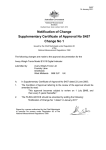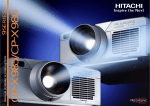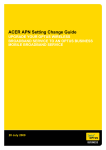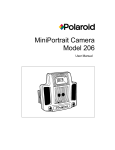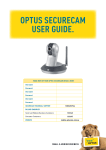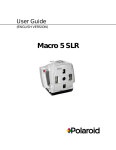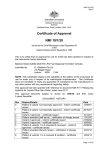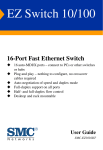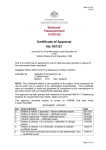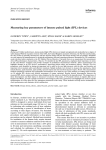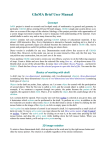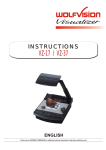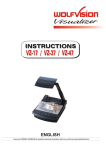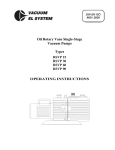Download Cargoscan Model CS5120 Dimensional Measuring Instrument
Transcript
13/1/3 13 April 2011 Bradfield Road, West Lindfield NSW 2070 Cancellation Certificate of Approval No 13/1/3 Issued by the Chief Metrologist under Regulation 60 of the National Measurement Regulations 1999 This is to certify that the approval for use for trade granted in respect of the Cargoscan Model CS5120 Dimensional Measuring Instrument submitted by Mettler Toledo Limited 220 Turner Street Port Melbourne VIC 3207 has been cancelled in respect of new instruments as from 1 May 2011. Signed by a person authorised by the Chief Metrologist to exercise his powers under Regulation 60 of the National Measurement Regulations 1999. 13/1/3 29 September 1997 National Standards Commission Certificate of Approval No 13/1/3 Issued under Regulation 9 of the National Measurement (Patterns of Measuring Instruments) Regulations This is to certify that an approval for use for trade has been granted in respect of the Cargoscan Model CS5120 Dimensional Measuring Instrument submitted by Mettler Toledo Limited 525 Graham Street Port Melbourne VIC 3207. NOTE: This Certificate relates to the suitability of the pattern of the instrument for use for trade only in respect of its metrological characteristics. This Certificate does not constitute or imply any guarantee of compliance by the manufacturer or any other person with any requirements regarding safety. CONDITIONS OF APPROVAL This approval becomes subject to review on 1 June 2002 and then every 5 years thereafter. Instruments purporting to comply with this approval shall be marked NSC No 13/1/3 and only by persons authorised by the submittor. ..../2 13/1/3 29 September 1997 Certificate of Approval No 13/1/3 Page 2 It is the submittor’s responsibility to ensure that all instruments marked with this approval number are constructed as described in the documentation lodged with the Commission and with the relevant Certificate of Approval and Technical Schedule. Failure to comply with this Condition may attract penalties under Section 19B of the National Measurement Act and may result in cancellation or withdrawal of the approval, in accordance with the Commission’s Document 106. The Commission reserves the right to examine any instrument or component of an instrument purporting to comply with this approval. Auxiliary devices used with this instrument shall comply with the requirements of general Supplementary Certificate No S1/0/A. DESCRIPTIVE ADVICE Pattern: approved 30 May 1997 • A Cargoscan model CS5120 semi-automatic dimensional measuring instrument. Variant: approved 30 May 1997 1. With a roller conveyor receptor. Technical Schedule No 13/1/3 describes the pattern and variant 1. FILING ADVICE Certificate of Approval No 13/1/3 dated 29 September 1997 Technical Schedule No 13/1/3 dated 29 September 1997 (incl. Test Procedure) Figures 1 to 4 dated 29 September 1997 Signed and sealed by a person authorised under Regulation 9 of the National Measurement (Patterns of Measuring Instruments) Regulations to exercise the powers and functions of the Commission under this Regulation. 13/1/3 29 September 1997 TECHNICAL SCHEDULE No 13/1/3 Pattern: Cargoscan Model CS5120 Dimensional Measuring Instrument. Submittor: 1. Mettler Toledo Limited 525 Graham Street Port Melbourne VIC 3207. Description of Pattern A Cargoscan model CS5120 semi-automatic dimensional measuring instrument which is approved for use to measure the linear dimensions of certain objects. 1.1 Details The pattern is approved to measure linear dimensions of objects having maximum dimensions (i.e. length x width x height) of 100 x 60 x 75 cm and minimum dimensions of 5 x 5 x 5 cm, with a scale interval (d) of 0.5 cm. The pattern is fitted with either a flat surface receptor or a ball-top receptor (Figures 1 and 2). An object is placed on the receptor and the operator presses the start button (or pedal). The motor-driven measuring head is then pulled along its support rail by a toothed belt. The object must be stationary during the measuring process, and a notice to this effect is prominently displayed. 1.2 Measuring Head The measuring head (Figure 3) has a laser rangefinder that scans the object via an optical scanning mechanism consisting of a rotating polygon with 6 mirrors and a curved deflection mirror, to detect the outer characteristics of the object. A computer in the measuring head converts the detected characteristics into the linear dimensions of the smallest rectangular box (parallelepiped - #) that would fully contain the object. From these dimensions the volume is calculated; from this volume, a ‘deemed weight’ (DW ...kg) is determined by means of a conversion factor. (#) A rectangular box (parallelepiped) is a polyhedron having six faces that are parallel in pairs; each face is a parallelogram and adjacent edges are perpendicular. ..../2 13/1/3 29 September 1997 Technical Schedule No 13/1/3 Page 2 1.3 Indicator/Control Panel The model 02650001000 indicator/control panel (Figure 3) has buttons to control the operation, and also displays the linear dimensions (in units of 0.5 cm) and also the calculated ‘deemed weight’ (in units of DW 0.1 kg). The volume to ‘deemed weight’ conversion factor (F) may be displayed by using the procedure set out in the Cargoscan document Installation Manual, version 1.4 part number 790001, dated June 1997. The limitations of use are set out in the Cargoscan document Working Principles, version 1.1 part number 790019, dated February 1996. The instrument has a number of alarm functions which display error messages if the object is too big, too small, outside the measurement field, too reflective, etc. An explanation of alarm functions is given in the Cargoscan document User’s Manual, version 1.6 part number 790019, dated June 1997. 1.4 Verification/Certification Provision Provision is made for the application of a verification/certification mark. 1.5 Markings Instruments carry the following markings, in the form shown at right: Manufacturer’s mark, or name written in full Model designation Serial number of the instrument Year of manufacture Pattern approval mark Maximum dimensions for each axis Minimum dimensions for each axis Scale interval Receptor type NSC No 13/1/3 Max ............ cm Min .............cm d = ............. cm In addition, instruments carry a notice stating THE OBJECT MUST BE STATIONARY DURING THE MEASURING PROCESS, or similar wording. 1.6 Sealing Provision Provision is made for sealing the calibration adjustments in the indicator/ control panel by means of the sealing screws that hold the two housing halves together. ..../3 13/1/3 29 September 1997 Technical Schedule No 13/1/3 2. Page 3 Description of Variant 1 With a roller conveyor receptor (Figure 4) in which case instruments may measure objects having maximum dimensions (i.e. length x width x height) of 100 x 60 x 75 cm and minimum dimensions of 12 x 12 x 5 cm. TEST PROCEDURE Maximum permissible error at verification/certification The maximum permissible error at verification/certification, expressed in terms of scale interval (d) is: ±1.0d for lengths from the minimum length to any value up to and including the maximum length capacity of the instrument. Test procedure Test objects shall be used, in the shape of rectangular boxes with known linear dimensions such that each axis (i.e. length x width x height) is tested for at least five dimensions between and including the minimum and maximum dimensions (approximately) specified on the instrument nameplate. Each test object shall be opaque, rigid and with flat faces and well-defined edges. All adjacent faces and edges shall be perpendicular to each other. The dimensions shall be equal to Nd and known to an uncertainty equal to or better than ±1/3d using a verified length standard. N is a whole number. Vary the position across the receptor, and the orientation of the test objects so that each axis is tested for the five dimensions. Check that the dimensions indicated on the indicator are within the maximum permissible error, i.e. the display is either Nd or (N±1)d. Check that the ‘deemed weight’ indicated is equal to the ‘deemed weight’ calculated using the displayed dimensions and the conversion factor (F) rounded to the nearest DW 0.1 kg. 13/1/3 23 January 2004 12 Lyonpark Road, North Ryde NSW 2113 Australia Notification of Change Certificate of Approval No 13/1/3 Change No 1 The following changes are made to the approval documentation for the Cargoscan Model CS5120 Dimensional Measuring Instrument submitted by 1. Mettler Toledo Limited now of 220 Turner Street Port Melbourne VIC 3207. In Certificate of Approval No 13/1/3 dated 29 September 1997, the Condition of Approval referring to the review of the approval should be amended to read: “This approval becomes subject to review on 1 June 2007, and then every 5 years thereafter.” 2. In Technical Schedule No 13/1/3 dated 29 September 1997, the address of the submittor should be amended to read: “220 Turner Street Port Melbourne VIC 3207”. Signed by a person authorised under Regulation 60 of the National Measurement Regulations 1999 to exercise the powers and functions of the Commission under this Regulation. 13/1/3 29 September 1997 FIGURE 13/1/3 - 1 Cargoscan Model CS5120 With Flat Surface Receptor 13/1/3 29 September 1997 FIGURE 13/1/3 - 2 Model CS5120 With Ball-top Receptor Showing Measuring Head and Indicator/Control Panel FIGURE 13/1/3 - 3 13/1/3 29 September 1997 13/1/3 29 September 1997 FIGURE 13/1/3 - 4 Model CS5120 With Roller Conveyor Receptor











